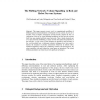Free Online Productivity Tools
i2Speak
i2Symbol
i2OCR
iTex2Img
iWeb2Print
iWeb2Shot
i2Type
iPdf2Split
iPdf2Merge
i2Bopomofo
i2Arabic
i2Style
i2Image
i2PDF
iLatex2Rtf
Sci2ools
ECAL
2001
Springer
2001
Springer
The Shifting Network: Volume Signalling in Real and Robot Nervous Systems
This paper presents recent work in computational modelling of diffusing gaseous neuromodulators in biological nervous systems. It goes on to describe work in adaptive autonomous systems directly inspired by this: an exploration of the use of virtual diffusing modulators in robot nervous systems built from non-standard artificial neural networks. These virtual chemicals act over space and time modulating a variety of node and connection properties in the networks. A wide variety of rich dynamics are possible in such systems; in the work described here, evolutionary robotics techniques have been used to harness the dynamics to produce autonomous behaviour in mobile robots. Detailed comparative analyses of evolutionary searches, and search spaces, for robot controllers with and without the virtual gases are introduced. The virtual diffusing modulators are found to provide significant advantages.
Artificial Intelligence | ECAL 2001 | Nervous Systems | Robot Nervous Systems | Virtual Diffusing Modulators |
| Added | 28 Jul 2010 |
| Updated | 28 Jul 2010 |
| Type | Conference |
| Year | 2001 |
| Where | ECAL |
| Authors | Phil Husbands, Andrew Philippides, Tom Smith, Michael O'Shea |
Comments (0)

